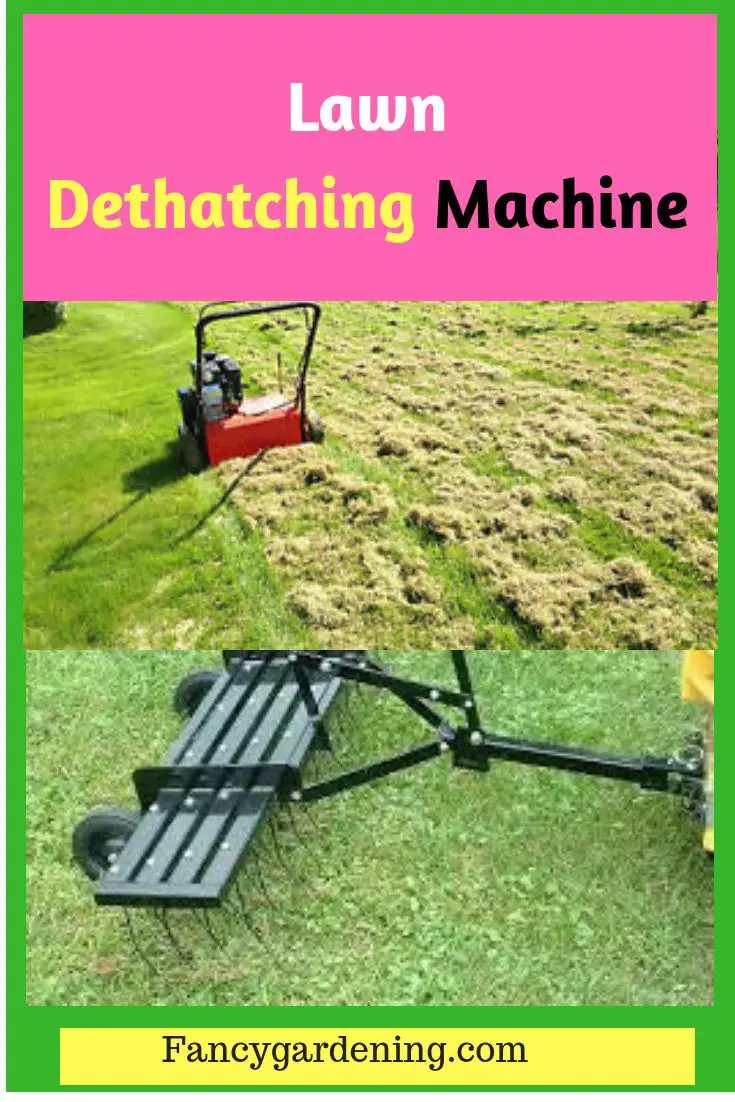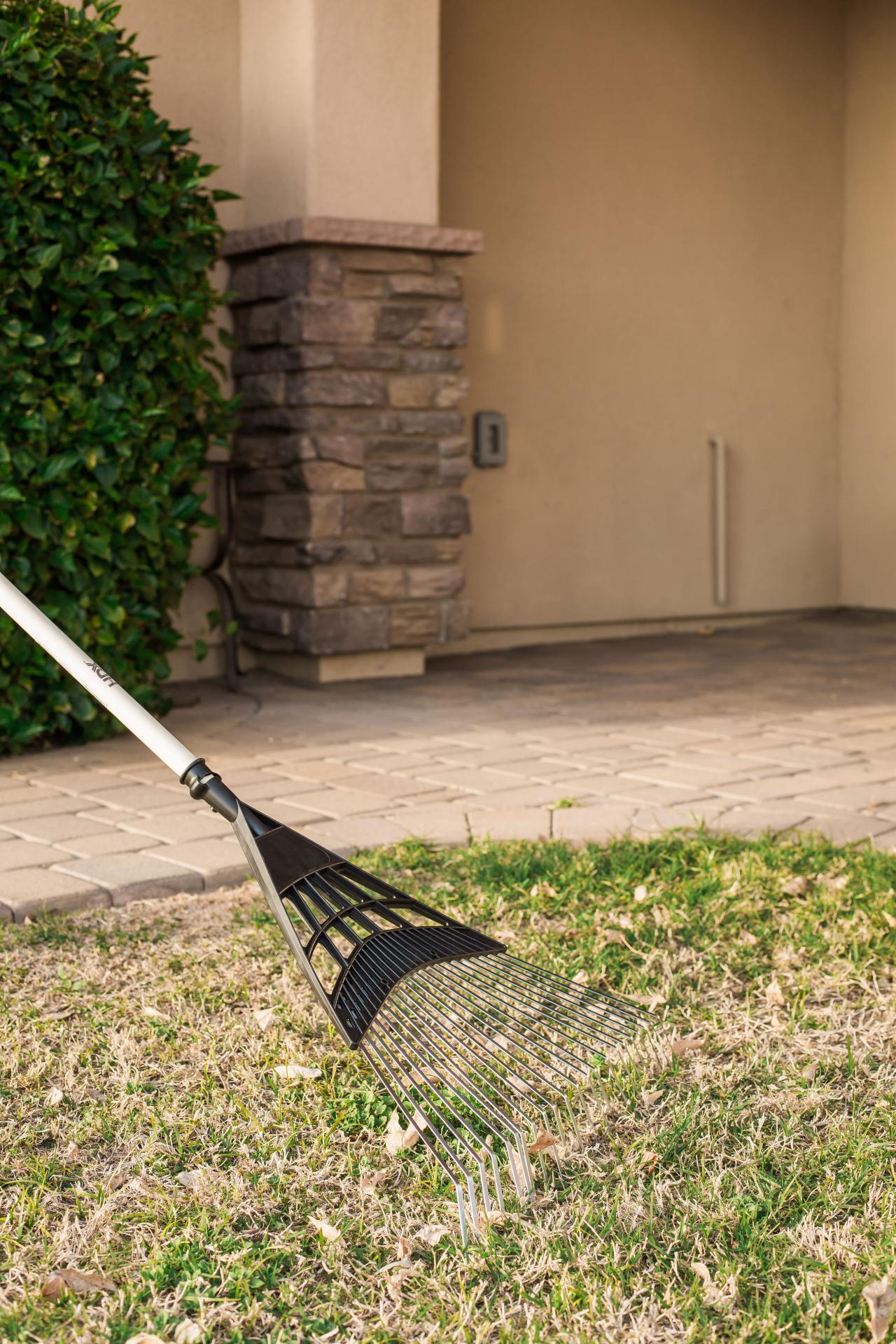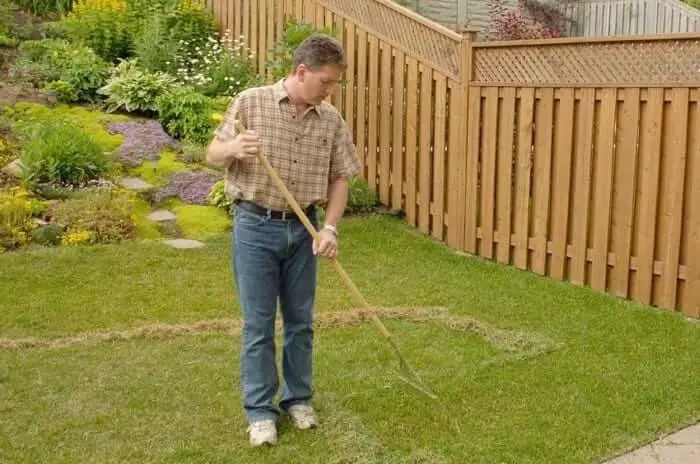What Is A Biological Liquid Dethatcher
The main ingredient in these products is a mixture of bacteria. Thatch decomposes naturally through the action of bacteria. It then follows that too much thatch indicates a lack of bacteria, so these products add more.
One product also contains something they call a carbonic enzymes, without specifying which ones. If you search for this term, it identifies a family of enzymes called Carbonic anhydrases, which assists rapid inter-conversion of carbon dioxide and water into carbonic acid, protons and bicarbonate ions. I see no connection between this reaction and the decomposition of thatch, and the manufacturer provides no explanation in their marketing material.
The Truth About Lawn Thatch
Thatch buildup in NOT the result of leaving clippings on the lawn.
let me say that again. Leaving clippings on your lawn WILL NOT cause thatch to build up. In fact, when combined with a safe, organic homemade liquid dethatching recipe , mulched-up grass clippings left on your lawn will actually reduce the amount of thatch.
The reason being that as the clippings decompose they also speed along the decomposition of old roots and rhizomes.
Thatch is simply the result of a buildup of old grass roots and rhizomes.
Different species of grass produce this natural thatch faster than other grass species, but all grasses produce their own natural thatch.
Know When To Remove Thatch
The best time to dethatch your lawn is just before the grass begins a period of active growth, which is spring for warm-season grasses such as Bermuda, St. Augustine and zoysia. Cool-season grasses such as Kentucky bluegrass are best dethatched just before their period of most active growth, in very early spring or early autumn.
Read Also: Violet Killer For Lawns
Choose The Appropriate Tool
To remove thatch from a relatively small yard, use a thatching rake, which has a series of closely spaced sharp, rigid blades. Simply pull the rake across the lawn to rip out the matted thatch.
A thatching rake is surprisingly fast and effective, but it can be very fatiguing after awhile. So, if youve got a large lawn save yourself some time and toil by renting a power dethatcher, which is a gas-powered, walk-behind machine thats armed with hundreds or sharp blades or flexible tines, as shown below. Simply run the machine back and forth across the lawn to remove the thatch.
Regardless of whether you use a thatching rake or dethatching machine, be sure to mark the locations of any sprinkler heads, shallow-buried cables, or other obstructions prior to dethatching the lawn.
Lawn Cultural Practices That Prevent Thatch

Lawn Mowing Never cut more than 1/3 of the blade of grass at one time. Mulching the grass clippings does not increase the tendency to build thatch. Change the mowing height to 2.5 inches in the spring and fall and increase the height to 3 inches or taller in the summer.
Lawn Fertilizing Fast release nitrogen lawn care applications will result in a decrease in thatch decomposition and an increase in thatch production rates. Always avoid high dosages of synthetic nitrogen sources like ammonium nitrate because they are salt based and kill beneficial microbes. Organic fertilizers stimulate beneficial microbial activity in the soil.
Lawn Irrigation Avoid light and frequent watering. Always irrigate the turf deeply and infrequently. This entices the roots of the grass to grow deep into the soil instead of the thatch layer. The lawn may look worse for a few weeks, but deep and infrequent watering will stimulate the roots to establish into the soil instead of the thatch.
Lawn Pesticide Pesticides negatively affect desirable microorganism and earthworm populations. Lawn care pesticides should be avoided unless absolutely necessary.
Thatch does not accumulate in a lawn from mulching grass clippings. Thatch accumulates from the lack of microorganism activity and buildup of organic matter due to the absence of a living soil.
Recommended Reading: Killing Wild Violet
How To Water A Lawn With Clay Soil
Proper lawn watering using the 1-2-3-2-1 lawn watering technique is the best way to water a lawn with clay soils because it will help prevent soil compaction. The best way to improve a clay soil is to create an environment that is teaming with microbes, a.k.a. a living soil.
A wonderful organic lawn care products that is designed to bust up clay soils is Humate soil conditioner. Humate is scientifically proven to stimulate microbial activity in the soil. Lawn aeration is also an important lawn care service that will help alleviate soil compaction and break up the heavy clay content of soils.
Aerate And Compost Topdress With Soil
Rent a core aerator to remove plugs of soil/turf from your lawn. The holes left in your lawn are portals for air, water, and compost to seep into and benefit the soil.
After aerating, topdress with Soil³ compost to further improve the growing conditions and reduce thatch. Microorganisms inherent in our Soil³ compost break down the thatch layer. They consume thatch and turn it into nutrients, thereby benefiting your lawn by providing natural nutrients which improve the health of your soil.
We recommend aerating and topdressing with Soil³ once a year, when your lawn is fully green and actively growing.
Recommended Reading: How To Kill Spiders In Lawn
How To Deal With Lawn Thatch
Thatch in lawns is most common in acidic and compact soil. The spongy lawn is a result of many factors such as excess nitrogen, disease and pest problems, as well as improper mowing. Correct cultural practices will help reduce the amount of thatch that forms.
You can also choose a grass variety that is less prone to thatch formation. Grasses that grow slowly, such as tall fescue, zoysia grass, and perennial ryegrass produce relatively little thatch.
Dethatch your lawn mechanically in late summer or early fall when your lawn has slowed down its growth for the season.
Choose A Method For Dethatching
For shallow thatch on small areas, use a stiff lawn rake. For small lawns with more than an inch of thatch, use a special thatch rake. Pull the blade-like tines across the lawn, cutting through the thatch. Work in small sections, and then remove the debris with a rake. Large areas and thick layers call for power rakes or vertical mowers, which are available from rental agencies. To use a power rake, adjust the cutters to slice through just the thatch layer. Check the cutter depth after the first few feet. Run the machine in parallel rows over the lawn and then again at 90 degrees to the first pass. Remove debris with a lawn rake.
Read Also: Where Are Cub Cadet Lawn Mowers Made
How Do I Dethatch My Lawn By Hand
Dethatch the Lawn In early spring, and for small areas, use a thatching rake, which is a sharp-tined rake that rips the thatch out of the lawn. Leaf rakes or hard rakes can be used but may not work as well. Rake the grass, digging deep to penetrate the thatch and loosen it apart.
Can you Dethatch with a regular rake?
In early spring, and for small areas, use a thatching rake, which is a sharp-tined rake that rips the thatch out of the lawn. Leaf rakes or hard rakes can be used but may not work as well. Rake the grass, digging deep to penetrate the thatch and loosen it apart.
How do you get rid of thatch by hand?
Why Buy An Agri
The Agri-Fab, Inc. 40â Tine De-thatcher Model #45-0294 will have your grass growing better in no time. Tine de-thatchers effectively loosen and lift thatch for healthier lawn growth. The best time to de-thatch is in the fall, because it allows water and nutrients to reach the grass roots in preparation for the spring. A universal hitch attaches to any tractor, regardless of brand. The Agri-Fab, Inc. 40â Tine De-thatcher Model #45-0294 will last you for years to come with proper care and use.
- The 40â Agri-Fab de-thatcher effectively uproots dead, matted grass swathes up to 40â in length.
- The 40â groomer has 20 rust-proof and replaceable heat-treated tines for maximum performance and durability.
- Two 7â flat free wheels provide smooth transport. Simple-to-use cantilever transport handle for easy raising and lowering of the tines.
- The 40â weight tray holds up to 70 lbs. for improved thatch removal.
| 7″ x 1 3/8″ flat free wheels | 7″ x 1 3/8″ flat free wheels | N/A |
| Durable heavy-gauge steel deck and welded drawbar | Durable heavy-gauge steel deck and welded drawbar | Durable heavy gauge steel |
| Simple-to-use cantilever transport handle for easy raising and lowering | Simple-to-use cantilever transport handle for easy raising and lowering | N/A |
| Universal hitch attaches quickly and easily to any brand of tractor | Universal hitch attaches quickly and easily to any brand of tractor | N/A |
You May Like: How To Clean Lawn Mower Carburetor
Why Does Thatch Need Removing
Its important to note, not all thatch is bad, in fact, some is beneficial to lawn promotion and health. At the right amount it can help conserve moisture and keep the soils temperature constant while sill allowing water, nutrients and air to reach the soil.
Thatch thats thicker than 1/2, can prevent water, fertilizer and air from reaching the soil and therefore the roots of the grass and this is why it must be removed.
How Do I Get Rid Of Thatch In My Lawn

Was this information helpful?
Don’t Miss: How Much To Pay Teenager To Mow Lawn
Whens The Best Time To Dethatch My Grass
Its important to know that dethatching is very stressful for the grass. Therefore you want to do it under ideal growing conditions to ensure an easy and swift recovery.
The best conditions for dethatching is in warm sunny weather, add some water after the job and youve then got the perfect elements the grass needs for recovery.
Warm weather will also prevent moss and weeds from growing after the dethatching has taken place.
Less thatch, less moss promotion, more water and fertilizer getting to the soil, means your grass will grow quicker and greener.
Thatch And Compaction: 2 Problems You Can Fix
Over time, little bits and pieces of grass die and gather just above the soil. This is called thatch. A little bit of thatch can be beneficial. It’s organic material that is broken down by microbes in the soil. But sometimes, thatch builds up too fast for natural processes to break it down. It forms a barrier, keeping moisture and air from going where your grass needs it. A half-inch or more of thatch can weaken your lawn. You have 2 ways to remove it: dethatching and aerating.
You May Like: How To Get Rid Of White Grubs In Lawn
Dethatching And Aerating Your Lawn
Keep grass healthy by controlling thatch
Controlling thatch is one of the most important and most overlooked parts of lawn care. Thatch is simply the layer of dead grass, roots, and debris that accumulates between the soil surface and the green grass blades above. Over time, it forms a thick mat, hindering water and air from reaching the soil and providing an environment that can encourage pests and diseases. Dethatching can help prevent these problems.
Dethatching
Almost every lawn needs dethatching about once a year, or whenever the thatch reaches a thickness of about 1/2 inch. To check, just work your fingers into the grass and note the depth of the thatch layer. Dethatch cool-season grasses in fall, warm-season types in early spring.
If your lawn is small, you can dethatch it with a special dethatching rake. The sturdy, very sharp, crescent-shaped tines slice into the thatch, then rake it up. For larger lawns, you may prefer to rent a dethatching machine. Similar in appearance to a large, heavy gas mower, it has knifelike blades that slice the turf vertically. Make several crisscrossing passes to cut and loosen the thatch, then rake up and remove all debris. Dethatching machines have several settings. For most grasses, adjust the blades to a high setting and 3 inches apart for tougher grasses, such as Bermuda and zoysia, set the blades lower and about an inch apart.
Aeration
Keep Reading:
How To Know When Thatch Is Too Thick
Often its clear to see, youll notice hay like grass amongst your green grass. To be sure, gently rake away at the grass and if the thatch easily removes itself , then your grass can do with a comb over.
If its unclear to the naked eye, you may remove a plug from the lawn and measure the thickness of thatch. If this measures greater than 1/2, its time to thatch that lawn to promote air circulation and water getting to the soil.
Recommended Reading: What Do Lawn Care Companies Do In The Winter
The Turf Titan Advantage
EASY TO USEThatch Buster breaks down thatch and allows water and nutrients deep into the ground for a healthier lawn. Apply to your lawn through a hose-end or pump sprayer. |
SAFE TO USETurf Titan Thatch Buster is safe for all lawns and grass types. It is also safe for your family, including pets. |
TRUSTED TO USETurf Titan Thatch Buster is made of commercial-grade all-natural ingredients that have been used worldwide on millions of acres to ensure quality results. |
When To Aerate Your Lawn
You want to aerate the lawn when your grass is in its peak growing period so it can recover quicklythink early spring or fall for cool-season grasses, and late spring through early summer for warm-season grasses. If you have high-traffic areas or heavy clay soil, you will want to aerate every year. If you have sandy soil or your lawn is growing well, aerating the lawn can happen every 2-3 years.
Recommended Reading: Who Makes The Best Riding Lawn Mower
How Do You Stop Liquid Dethatchers
Lets say I am wrong and liquid dethatchers work. You add the microbes to the lawn and they start decomposing the thatch. Things are looking good. Your 1.5 of thatch is slowly getting less with each passing day.
Things are going so good that the thatch layer is now at the 1/2 mark. You dont want the layer to get any less because that is not good for the lawn. How do you stop the microbes?
If they were GMO microbes they might be smart enough to stop on their own, but these are just natural microbes. They dont know enough to stop.
I think you can see that even if these products worked, the idea that they would produce a healthy lawn is flawed.
When To Use Pesticides

Avoid using pesticides as much as possible. Many pesticides affect the microbial and earthworm populations that are involved in decomposing the thatch layer.
Use pesticides only when a pest problem has been clearly identified and the pesticide is necessary and known to be effective.
CAUTION: Mention of a pesticide or use of a pesticide label is for educational purposes only. Always follow the pesticide label directions attached to the pesticide container you are using. Remember, the label is the law.
Also Check: How To Change Oil In Craftsman Lawn Mower
When To Vertical Mow
The best time for vertical mowing is usually between late August and early October, depending on your location, because grass is growing vigorously then and should recover quickly from any damage. In addition, few weed seeds germinate at that time. A light application of fertilizer and regular watering will speed the lawns recovery after vertical mowing.
Sam Bauer, Extension educator, Deborah Brown and Don Taylor
Reviewed in 2018
Let Your Lawn Breathe
The Go-To Tool to Get Your Lawn in Tip-Top Shape
Get your lawn in top green shape with the Sun Joe Dethatcher Joe AJ801E 12.6-inch electric scarifier + lawn dethatcher.
Powered by a robust 12-amp motor, the Dethatcher Joe rakes a 12.6-inch wide path in a single pass to get your job done fast.
- Ideal for revitalizing small to mid-sized lawns
- Scarifier function to cut grass roots for thicker growth, healthier lawns
- Tailor raking depth with 5-position depth control
Read Also: How To Get Rid Of Wild Violets In Your Lawn
Thatch Recognizing It And Removing It
What is Thatch?
Thatch is a matted layer of dead grass, roots and other matter that builds up in grass over time. Its very common and collects on most lawns at some time or another. Thatch collects above the soil at surface level and becomes intertwined in grass stems. When the cycle of decomposition is delayed for any variety of reasons, dead matter will begin to build up. As the build up increases the dead matter becomes stacked and then packs down or mattes and causes healthy grass blades to become stressed and weak the lawn thins, and eventually dies. This will typically be evident in a lawn which is undernourished and has a yellow green appearance rather than the more preferred Grass Green colour.
Thatch can actually choke a lawn to death! As it thickens it robs the soil of air and hinders water absorption and nutrient penetration to the soil and root system. Not only will excessive thatch kill the grass, left undeterred long enough it will damage the soil so that even if removed, new growth in that area will be sparse at best. Thick thatch levels can also become a haven for insects. Moisture rich matted thatch can be an excellent breading ground for insects and disease.
Thatch creates a water barrier, prevents new grass from growing and harbors insects. It collects quickly and before long the lawn and its entire root system is at risk.
Controlling Nuisance Thatch
Moderate Thatch
Excessive Thatch and the Need for Aeration
When to Dethatch Your Lawn
